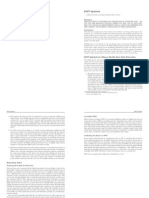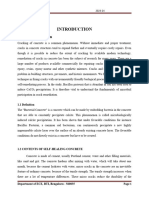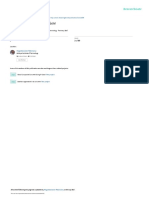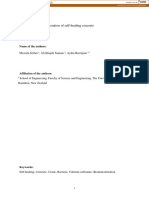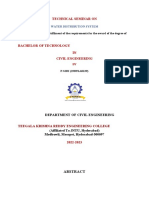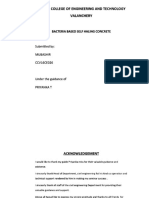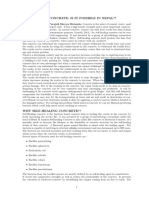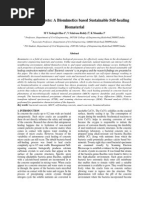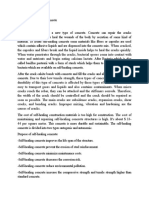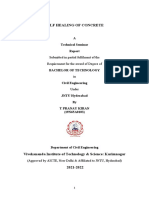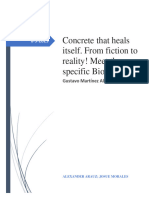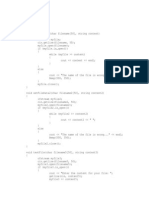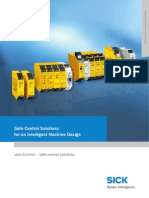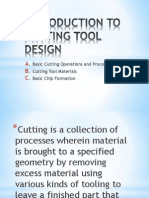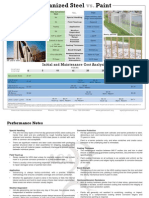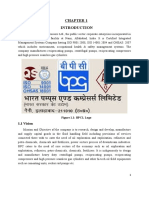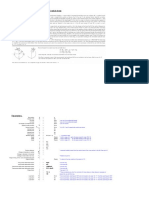Self Healing1
Self Healing1
Uploaded by
Gaurav ChauhanCopyright:
Available Formats
Self Healing1
Self Healing1
Uploaded by
Gaurav ChauhanOriginal Description:
Copyright
Available Formats
Share this document
Did you find this document useful?
Is this content inappropriate?
Copyright:
Available Formats
Self Healing1
Self Healing1
Uploaded by
Gaurav ChauhanCopyright:
Available Formats
IOSR Journal of Mechanical and Civil Engineering (IOSR-JMCE)
e-ISSN: 2278-1684,p-ISSN: 2320-334X,
PP 01-07
www.iosrjournals.org
Strength And Durabilityassessment Of Bacteria Based Self-
Healing Concrete
Meera C. M.1, Dr. Subha V.2
1
(Department of Civil Engineering, Sree Narayana Gurukulam College of Engineering, India)
2
(Department of Civil Engineering, SOE, Cochin University of Science and Technology, India)
Abstract: In recent years, there is increasing interest in the phenomenon of mechanical property recovery in
concrete construction using self-healing concrete. The study was motivated by the need to find a solution for the
problem of cracking approaching the concept of self-healing concrete. The study was carried out on a bacteria
based self-healing concrete using Bacillus Subtilis bacteria. The present paper describes the effect of this
bacteria on the strength of concrete. An investigation on the strength assessment of the bacteria-based self-
healing concrete by finding out the optimum amount of bacterial content to be added to obtain maximum
strength is depicted in this.
Keywords - Bacillus Subtilis, Bacterial concrete, Self–healing
I. Introduction
Concrete is a major material used in the construction field, from the foundation of buildings to the
structures of bridges and dams. Several construction techniques without incorporating concrete have been
developed but concrete still continues to be the most important building material for infrastructure. The major
shortcoming of concrete is that it tends to crack when subjected to tension. Tiny cracks formed on the surface of
the concrete make the whole structure vulnerable due to seepage of water into the concrete, promoting corrosion
of the steel reinforcement, thus reducing the life span of the structure. Self-healing concrete is a solution to this
problem of durability of concrete structures and has also received increasing attention as a smart material with
interesting potential applications in civil infrastructure. Self-healing materials used in such type of concrete have
the ability to heal the damage inflicted on the concrete partially or completely, thereby restoring the original
functionality of the structure. Self-healing system can achieve a tremendous cost reduction in terms of health
monitoring, damage detection and maintenance of concrete structures, assuring a safe service life of the structure.
II. Types of Self-Healing Mechanism
Autonomous self-healing is defined as a purposely designed self-healing mechanism. In this case a
cementitious healing agent can be used in the presence of water as a prerequisite for the self-healing process to
happen. A cementitious healing agent requires water in order to become effective. In absence of water healing
will not occur. The water may penetrate into a crack from external sources. Alternatively water-saturated porous
lightweight aggregate particles can be added to the concrete mixture. These particles may release water when a
crack occurs and moisture gradients stimulate the flow of water[1].
2.1 Autogenous Self-healing Mechanism
Most of the traditional concrete mixes was left up with 20-30% unhydrated cement, when exposed to
moisture through cracks hydrates, fill up and heal the cracks. The amount of unreacted cement was higher the
coarser the cement and the lower the water/cement ratio of the mixture. If cracking of the concrete occurs,
unreacted cement grains may become exposed to moisture penetrating the crack. In that case the hydration
process may start again and hydration products may fill up and heal the crack. This inherent self-healing
mechanism is known since long as autogenous healing[1]. This phenomena is termed to be the autogenous self-
healing mechanism of concrete. The autogenous healing of cracks has been noticed by scientists in water
retaining structures, culverts and pipes.
2.2 Autonomous Self-healing Mechanism
Autonomous self-healing is defined as a purposely designed self-healing mechanism. In this case a
cementitious healing agent can be used in the presence of water as a prerequisite for the self-healing process to
happen. A cementitious healing agent requires water in order to become effective. In absence of water healing
will not occur. The water may penetrate into a crack from external sources. Alternatively water-saturated porous
International Conference on Emerging Trends in Engineering & Management 1 |Page
(ICETEM-2016)
IOSR Journal of Mechanical and Civil Engineering (IOSR-JMCE)
e-ISSN: 2278-1684,p-ISSN: 2320-334X,
PP 01-07
www.iosrjournals.org
lightweight aggregate particles can be added to the concrete mixture. These particles may release water when a
crack occurs and moisture gradients stimulate the flow of water[1].
2.3 Hollow Glass Fibre System
In the hollow glass fibre system, fibers containing healing agents are completely embedded into the
concrete. Hollow fibres filled with liquid healing agents are used in this system. Hollow Polypropylene fibers,
with methylmethacrylate as healing agent as is one such system[2]. The hollow glass fibre system can itself be
applied in two methods according to the delivery of the healing agents, as internal healing agent supply system
and external healing agent supply system. When cracks appear due to loading on the structure, the fibre breaks
and promotes the entry of liquid healing agent preserved in the fibre to the cracks and seal the cracks.
2.4 Microencapsulation System
Microencapsulation system is a system similar to hollow glass fibre system. This involves encapsulating
healing agents within microcapsules and adding to the concrete. The main idea of this method is encapsulation,
embedment, release and hardening of healing agents inside the host material matrix. Sodium silicate solution
stored in polyurethane microcapsules is one such system. The healing liquid encapsulated in the host matrix is
released when the capsules are ruptured by propagating cracks. It then reacts with the calcium hydroxide in
cement and produces a C-S-H gel that partially heals the cracks. Compressive strength is unaffected by the
presence of these capsules[3].
2.5 Shape Memory Alloy System
Shape memory alloy (SMA) system contain an equi-atomic composition of alloys that could exist in two
stable and distinct phases which are reversible under certain temperature and stress conditions. Nicket-Titanium
alloy is one such commonly used SMA in self-healing concrete. SMAs are characterized by two particular
behaviors. One is the shape memory effect, which refers to the ability of SMAs to undergo reversible
transformations between the two phases. In the martensite phase, SMAs are capable of regaining part of their
residual strain after unloading. Once heated to enter into the austenite phase, all residual strain can be regained
and the material could transform back to its original shape. Second is the super elasticity effect which refers to the
ability of the SMAs to deform plastically after certain stress levels in the austenite phase and retrieve their
original length and shape upon unloading with no residual strain. The shape memory effect and super elasticity
effect of the SMAs endow them with great potential for applications in self-healing materials[4].
2.6 Bacteria Based System
Bacteria based system involves the use of ureolytic bacteria of genus Bacillus for the production of
Calcium Carbonate minerals. The metabolism of this genus of bacteria involves the enzymatic hydrolysis of
urea to ammonia and carbon dioxide. The reaction also causes an increase of pH from neutral to alkaline
conditions forming bicarbonate and carbonate ions, which precipitate with the Calcium ions in the concrete to
form Calcium Carbonate minerals. The further crystalisation of the Calcium Carbonate minerals heals the pores
and cracks in the concrete[5].
III. Preparation of Bacterial Concrete
Bacteria are added to concrete mix in suspension state and it must meet certain criteria. Bacteria used as
self-healing agent should be able to survive high alkaline environment of concrete for long durations and be able
to form spores (highly resistant structures) withstanding mechanical forces during concrete mixing. A bacterial
concrete mix prepared using alkali-resistant soil bacteria Bacillus subtilis JC3 along with nutrients from which the
bacteria could potentially produce calcite based bio-minerals. The bacteria genus Bacillus has been found to
thrive the high-alkaline environment of concrete due to its extremely thick outer cell membrane that enables them
to remain viable until a suitable environment is available to grow. They would become active when the cracks
form on concrete surface allowing water to enter into the structure. This phenomenon will reduce the pH of the
concrete environment where the incorporated bacteria become activated. A peptone based nutrients supplied
along with bacteria content in suspension helps in producing calcite crystals.
IV. Working Principle Of Self-Healing Process
In concrete structures, the micro cracks up to 0.2 mm wide are healed autogenously due to hydration of
non-reacted cement particles present in the concrete matrix coming in contact with ingress water. The bacteria
International Conference on Emerging Trends in Engineering & Management 2 |Page
(ICETEM-2016)
IOSR Journal of Mechanical and Civil Engineering (IOSR-JMCE)
e-ISSN: 2278-1684,p-ISSN: 2320-334X,
PP 01-07
www.iosrjournals.org
based self-healing process has been found to heal cracks completely up to 0.5 mm width. On the surface of
control concrete, Calcium Carbonate will be formed due to the reaction of CO 2 present with Calcium Hydroxide
present in the concrete matrix according to the following reaction:
CO2 + Ca(OH)2 → CaCO3 + H2O …(1)
The Calcium Carbonate production in this case is rationed due to the limited amount of CO 2 present.
As Ca(OH)2 is a soluble mineral, it gets dissolved in entering water and diffuse out of the crack in the form of
leaching. The self-healing process in bacteria incorporated concrete is much more efficient due to the active
metabolic conversion of Calcium nutrients by the bacteria present in concrete:
Ca(C3H5O2)2 + 7O2 → CaCO3 + 5CO2 + 5H2O …(2)
Here Calcium Carbonate is produced directly due to microbial metabolic process and also indirectly
due to autogeneous healing. This process results in efficient bacteria-based crack sealing mechanism. Ureolytic
bacteria, Bacillus Subtilis JC3 can precipitate CaCO3 in the high alkaline environment by converting urea into
Ammonium and Carbonate. The Ammonia degradation of urea increases the pH locally and promotes the
microbial deposition of carbonate as calcite crystals in a calcium rich environment sealing the crack and
maintains the pH of concrete.
V. Materials And Methods
The following are the particulars of the materials used for concrete making.
5.1 Cement
Portland Pozzolana fly ash based cement is used in the investigation. The cement used has been tested
for various properties as per IS:4031-1988 and found to be confirming to various specifications of IS:12269-
1987. The cement has a specific gravity of 3.15, 38% of water content for standard consistency and 3% fineness.
5.2 Coarse Aggregate
The coarse aggregate of 20mm and down size, having a specific gravity of 2.83 and a fineness modulus
of 4.12, tested as per IS:2386-1963 is used.
5.3 Fine Aggregate
Natural river sand with specific gravity of 2.63 and confirming to IS:383 zone II is used. The sand was
tested as per IS:2386 (Part III) -1963. The sand is having percentage of water content at maximum bulking equal
to 7%.
5.4 Water
Locally available portable water confirming to standards specified in IS:456-2000 is used.
5.5 Microorganisms
Bacillus Subtilis JC3, a laboratory cultured bacterium collected from Kerala Agricultural University
Mannuthy, was used. Bacteria in suspension with a concentration of 10 8 cells/ml was collected and 103, 104, 105
and 106 cells/ml of bacterial concentration was made from the obtained sample
Table 1: Biochemical Characteristics Bacillus Subtilis Jc3
Characteristics Bacillus Subtilis JC3
Shape, size, gram stain Long rods, 2.0 to 3.0 μm in length and 0.6-0.8 μm in width gram
positive (refer fig.1)
Colony morphology (on nutrient agar plate) Irregular, dry, white, opaque colonies (refer fig.2)
Fermentation: Lactose No acid, no gas
Dextrose No acid, no gas
Sucrose Acid and gas
H2S production -
Nitrate reduction -
Indole production -
Methyl Red test -
Vogesproskauer test -
International Conference on Emerging Trends in Engineering & Management 3 |Page
(ICETEM-2016)
IOSR Journal of Mechanical and Civil Engineering (IOSR-JMCE)
e-ISSN: 2278-1684,p-ISSN: 2320-334X,
PP 01-07
www.iosrjournals.org
Citrate utilization -
Catalase activity +
Gelatin liquefaction +
Starch hydrolysis +
Lipid hydrolysis +
Note: “+” :- Present “-“ :- Absent [Sunil et. al. 2010]
Figure 1: Phase contrast microphotograph of strain JC3 (Long rods, 0.6-0.8 μm in width and 2.0 to 3.0 μm in length,
gram positive) [Sunil et. al. 2010]
Figure 2: Colony morphology of strain JC3 on nutrient agar plate (Irregular, dry, white, opaque colonies) [Sunil et.
al. 2010]
VI. Culturing And Maintenance Of Bacteria
The pure culture was isolated from soil sample and was to be maintained constantly on nutrient agar
slants. The bacteria, then forms irregular dry white colonies on the nutrient agar. Whenever requisite a single
colony of the culture has to be inoculated into nutrient broth of 25 ml in 100 ml conical flask and the growth
environment is maintained at 370°C temperature and placed in 125 rpm orbital shaker. The medium
composition that is required for growth of the culture has been adopted as 5 g/lt Peptone, 5 g/lt NaCl and 3 g/lt
Yeast extract. After 2 to 3 days of growth, slant cultures have to be preserved under refrigeration (4°C) until
further use. Sub culturing was to be carried out for every 90 days. Contamination from other bacteria has to be
checked periodically by streaking on nutrient agar plates.
VII. Tests On Concrete
7.1 Srength assessment
The cubes and cylinders were prepared for concrete mix of M20 grade with and without addition of
microorganisms (B. Subtilis). The size of the cubes was 150mm x 150mm x150mm and cylinders was taken as
100mm diameter 200mm height respectively. Cubes were tested for compressive strength at 7 days and 28 days.
Cylinders were tested for split tensile strength at 28 days.
International Conference on Emerging Trends in Engineering & Management 4 |Page
(ICETEM-2016)
IOSR Journal of Mechanical and Civil Engineering (IOSR-JMCE)
e-ISSN: 2278-1684,p-ISSN: 2320-334X,
PP 01-07
www.iosrjournals.org
7.2 Durability assessment
An experimental program was conducted on M20 grade concrete cubes of size 150mm x 150mm
x150mm with and without addition of microorganisms (B. Subtilis). Specimens were immersed in 5% solution of
H2SO4 for Acid Durability Tests, 5% solution of NaCl for Chloride Test and in distilled water for Water
Absorption Test. The specimens were arranged in plastic tubs with a clearance around and above the specimen is
not less than 30 mm. The response of the specimens to the solutions was evaluated through change in appearance,
weight, compressive strength, thickness. Before testing, each specimen was removed from the baths, and brushed
with a soft nylon brush and rinsed in tap water. This process removes loose surface material from the
specimens[6].
VIII. Results And Discussion
The compressive strength of concrete for specimens with different bacterial concentration at 7 days and
28 days are given in Table 2. It was observed that the compressive strength of concrete showed significant
increase by 42% for cell concentration of 105 of mixing water. The Split Tensile Strength on standard cylindrical
specimens with different bacterial concentration at 28 days, are given in Table 3. It was observed that with the
addition of bacteria there is a significant increase in the tensile strength by 63% for a bacteria concentration of 105
cells/ml at 28 days. As the results of strength tests on samples of various bacterial concentrations gave preeminent
values for the samples with bacterial concentration 10 5 cells/ml, further investigations on the durability
assessment was made on the bacterial concrete with the same concentration.
Investigations on the durability assessment were made as a comparative study of bacterial concrete
with 105 cells/ml concentrations and the control mix concrete. The results of Acid Test of the loss in weight and
compressive strength are given in Table 4. From the results it could be inferred that the addition of bacteria
prevents the loss in weight during acid exposure to a certain limit proving the bacterial concrete to have higher
Acid Attack Factor. Also, the relatively higher compressive strength by the bacterial when compared to control
concrete proves it to have higher Acid Durability Factor on comparison with the conventional concrete. The
results of Water Absorption Test, given in Table 5 shows lesser increase in weight of bacteria concrete sample
than control, from which it could be reckoned that the concrete will become less porous due to the formation of
Calcium Carbonate due to which it resulted in lesser water absorption rate. Chloride test results, as given in
Table 6, shows that the addition of bacteria decreases weight loss due to Chloride exposure and enhances the
Compressive Strength.
Table 2: Effect Of The Bacillus Subtilis Jc3 Bacteria Addition On Compressive Strength
Cell concentration/ml of Average Compressive Strength of Concrete Cube in Mpa
mixing water 7 days % increase 28 days % increase
100 (Control mix) 11.55 - 17.77 -
3
10 13.33 15.41 18.67 5.06
4
10 14.22 23.12 24.88 40.01
5
10 14.33 24.07 25.33 42.54
6
10 14.22 23.12 18.67 5.06
Table 3: Effect Of The Bacillus Subtilis Jc3 Bacteria Addition On Split Tensile Strength
Average Split Tensile Strength of Concrete
Cell concentration/ml Cylinder in Mpa
of mixing water
28 days % increase
0
10 (Control mix) 1.56 -
3
10 2.12 35.90
4
10 2.26 44.87
5
10 2.55 63.46
106 2.26 44.87
International Conference on Emerging Trends in Engineering & Management 5 |Page
(ICETEM-2016)
IOSR Journal of Mechanical and Civil Engineering (IOSR-JMCE)
e-ISSN: 2278-1684,p-ISSN: 2320-334X,
PP 01-07
www.iosrjournals.org
Table 4: Effect Of The Bacillus Subtilis Jc3 Bacteria Addition On Acid Test
Average Compressive Average % loss in
Strength Cube (MPa) weight
Type of mix
90 90 %
% increase
days days decrease
Control mix 17.93 - 0.52 -
Bacterial concrete
of 105 cells/ml 18.67 4.13 0.36 44.44
concentration
Table 5: Effect Of The Bacillus Subtilis Jc3 Bacteria Addition On Water Absorption Test
Average increase
% Decrease of
in weight due to
Type of mix water
water absorption
absorption rate
in %
Control mix 0.443 -
Bacterial
concrete of 105
0.368 16.93
cells/ml
concentration
Table 6: Effect Of The Bacillus Subtilis Jc3 Bacteria Addition On Chloride Test
Average
Compressive Average % loss
Strength Cube in weight
Type of mix
(MPa)
90 % 90 %
days increase days decrease
Control mix 32.88 - 0.86 -
Bacterial
concrete of
34.66 5.41 0.36 58.14
105 cells/ml
concentration
Figure 3: Variation of 7 days and 28 days compressive strength and split tensile strength of concrete samples
according to bacterial concentration
International Conference on Emerging Trends in Engineering & Management 6 |Page
(ICETEM-2016)
IOSR Journal of Mechanical and Civil Engineering (IOSR-JMCE)
e-ISSN: 2278-1684,p-ISSN: 2320-334X,
PP 01-07
www.iosrjournals.org
IX. Conclusion
The experimental study shows that the addition of bacteria Bacillus Subtilis JC3 in concrete shows
improvements in various properties of concrete in terms of compressive strength, split tensile strength, porosity,
acid resistance and chloride resistance. As the bacteria can be produced in the laboratory, it could be proved to be
safe and very cost effective. Bacterial concrete with a concentration of bacteria of 105cells/ml was found to give
best results out of the samples used. Hence it could be concluded that this particular concentration give optimum
results which is proven by 42% increase in compressive strength and 63% increase in split tensile strength when
compared to conventional concrete. Durability tests relieved that bacterial concrete have higher Acid Durability
Factor and higher Acid Attack Factor from Acid Tests results. Bacterial concrete exhibited lower rate of water
absorption than conventional concrete. This is due to the bacteria induced formation of Calcium Carbonate in the
pores present in concrete, leading to a lesser voids and hence a lesser permeability. Bacterial concrete is less
vulnerable to Chloride Attack also. The study accomplishes that the use of bacteria (Bacillus Subtilis) in concrete
enhances its strength and durability hence using this type of bacteria for self-healing mechanism in concrete can
produce cost effective strong or durable structures.
Acknowledgements
We would like to express gratitude to Akbar Shah A. A., Gayathri S., Ponnu S. V. and Smitha Thomas
of Department of Civil Engineering, Sree Narayana Gurukulam College of Engineering, Kadayiruppu for their
sincere efforts in carrying out the experimental works to bring up this study.
References
[1]. Klaas van Breugel, Self-Healing Material Concepts As Solution For Aging Infrastructure, 37th Conference on Our World in
Concrete & Structures 29-31 August 2012, Singapore
[2]. Yueqiang Sui, Mechanical Behavior Of FRP-Confined Self-Healing Concrete, Master Thesis, Louisiana State University and
Agricultural and Mechanical College, Xiamen University, 2014
[3]. Sonja Then, Gan Seng Neon & Noor Hayaty Abu Kasim, Optimization of Microencapsulation Process for Self-Healing Polymeric
Material, Sains Malaysiana 40(7)(2011): 795–802
[4]. Song, G., Ma, N., and Li, H. N. (2006). Applications of shape memory alloys in civil structures. Engineering Structures, 28: 1266-
1274.
[5]. Henk M Jonkers, Erik Schalengon, A two composite bacteria based self healing concrete, Journal Of Cement And Concrete
Research, pp 215-220
[6]. S. Sunil Pratap Reddy, M. V. Seshagiri Rao, P. Aparna and C. H. Sasikala, Performance of Ordinary Grade Bacterial (Bacillus
Subtilis) Concrete, International Journal of Earth Sciences and Engineering, ISSN 0974-5904, Vol. 03, No. 01, February 2010, pp.
116-124
[7]. C.C. Gavimath, B.M.Mali, V.R.Hooli,A.B Patil, Potential application of bacteria to improve the strength of cement concrete,
International Journal of Advanced Biotechnology and Research (2011), pp 541-544.
[8]. J.Y. Wang1, K. Van Tittelboom1, N. De Belie1 and W. Verstraete,Potential of Applying Bacteria to Heal Cracks in Concrete,
Magnel Laboratory for Concrete Research, (2010)
[9]. Kim Van Tittleboom, Nele de Belie, Willem De Muyunk, Use of bacteria to repair cracks in concrete, Journal of Cement concrete
and Research (2010), pp 157-166.
[10]. R. S. Trask, G. J. Williams and I. P. Bond, Bioinspired self-healing of advanced composite structures using hollow glass fibres,
Journal of the Royal Society Interface (2007) 4, 363–371
[11]. S. Ghosh, M. Biswas a, B.D. Chattopadhyay, S. Mandal, Microbial activity on the microstructure of bacteria modified mortar ,
Journal of cement and concrete research(2009) , pp 93-98
[12]. Virginie Wiktor, Henk M Jonkers, Quantification of crack healing in novel bacteria based self healing concrete, Journal of cement
and concrete composites (2011), pp 763-770.
International Conference on Emerging Trends in Engineering & Management 7 |Page
(ICETEM-2016)
You might also like
- Vortex DMT Extraction Tek BKLTDocument6 pagesVortex DMT Extraction Tek BKLTDora L. Gutierrez100% (1)
- Otraco Web Publications Maximising Tyre Life September 2002 PDFDocument18 pagesOtraco Web Publications Maximising Tyre Life September 2002 PDFEmerson MercadoNo ratings yet
- Bioceramic Materials in Clinical EndodonticsFrom EverandBioceramic Materials in Clinical EndodonticsSaulius DrukteinisNo ratings yet
- Report :SELF HEALING CONCRETEDocument19 pagesReport :SELF HEALING CONCRETEPrabhat Kumar Sahu94% (18)
- Modal CorrelationDocument53 pagesModal CorrelationDasaka BrahmendraNo ratings yet
- Self Healing ConcreteDocument12 pagesSelf Healing ConcreteVivek Makhecha100% (2)
- Self Healing Concrete Synopsis PrintDocument7 pagesSelf Healing Concrete Synopsis PrintASHEESH KUMAR SRIVASTAVANo ratings yet
- Research PaperDocument5 pagesResearch PaperSatyendra PatelNo ratings yet
- Self Healing ConcreteDocument21 pagesSelf Healing ConcretethirumalNo ratings yet
- Amit RRDocument21 pagesAmit RRsfhjxdgh83No ratings yet
- Research Paper Satyendra PatelDocument4 pagesResearch Paper Satyendra PatelSatyendra PatelNo ratings yet
- Naresh Technical Seminar ReportDocument18 pagesNaresh Technical Seminar Reportbikesh20007No ratings yet
- IJCRT21X0040Document57 pagesIJCRT21X0040Shaik yahiya rizwanNo ratings yet
- Self Healing ConcreteDocument22 pagesSelf Healing ConcreteMarc Alamo100% (2)
- Bacterial Concrete: A Review: Pappupreethi K, Rajishavelluva AmmakunnothDocument7 pagesBacterial Concrete: A Review: Pappupreethi K, Rajishavelluva AmmakunnothIAEME PublicationNo ratings yet
- Self-Healing Concrete (Wiktor2011)Document8 pagesSelf-Healing Concrete (Wiktor2011)Jhon Smit Gonzales UscataNo ratings yet
- Ijciet 08 02 061Document8 pagesIjciet 08 02 061vikasNo ratings yet
- Research PaperDocument5 pagesResearch PaperSatyendra PatelNo ratings yet
- The Self-Healing Concrete-A Review: February 2018Document7 pagesThe Self-Healing Concrete-A Review: February 2018er.praveenraj30No ratings yet
- Routes and Mechanisms Towards Self Healing Behavior in Engineering MaterialsDocument5 pagesRoutes and Mechanisms Towards Self Healing Behavior in Engineering MaterialsvempadareddyNo ratings yet
- Ijciet 08 02 061Document8 pagesIjciet 08 02 061Ki KiethNo ratings yet
- Bioconcrete Next Generation of Self-Healing Concrete, Mostafa Seifan A, Ali Khajeh Samani A, Aydin Berenjian ADocument19 pagesBioconcrete Next Generation of Self-Healing Concrete, Mostafa Seifan A, Ali Khajeh Samani A, Aydin Berenjian AGR DesignsNo ratings yet
- Self-Healing Concrete: A Seminar SynopsisDocument5 pagesSelf-Healing Concrete: A Seminar SynopsisK SandeepNo ratings yet
- Self Healing ConcreteDocument8 pagesSelf Healing ConcreteRitesh kumar Sharma0% (1)
- Self Healing Concretre SITDocument36 pagesSelf Healing Concretre SITgaurav jhaNo ratings yet
- SEMINARDocument12 pagesSEMINARVishala SharmaNo ratings yet
- 4I43 IJAET1101811 v11 I1 pp29 34Document7 pages4I43 IJAET1101811 v11 I1 pp29 34aremanisha2003No ratings yet
- Self Healing BookDocument16 pagesSelf Healing BookSHANMUGAVEL KUMARNo ratings yet
- VNRVJIETDocument19 pagesVNRVJIETvempadareddyNo ratings yet
- Self Healing Concrete - A Sustainable Future: B. E. Civil Engineering G.H.R.C.E.M.,, PUNEDocument7 pagesSelf Healing Concrete - A Sustainable Future: B. E. Civil Engineering G.H.R.C.E.M.,, PUNETejaswiniNo ratings yet
- Self Healing ConcreteDocument17 pagesSelf Healing ConcreteSirajUdDinNo ratings yet
- Bacterial ConcreteDocument21 pagesBacterial Concretesubeersubi720No ratings yet
- Microbial Induced Calcite Precipitation For Self-Healing of Concrete A ReviewDocument15 pagesMicrobial Induced Calcite Precipitation For Self-Healing of Concrete A Reviewdivya agarwalNo ratings yet
- BioconcreteDocument12 pagesBioconcreteMoeesha KenkreNo ratings yet
- Self Healing ConcreteDocument13 pagesSelf Healing ConcreteAbigail VNo ratings yet
- Bio ConcreteDocument3 pagesBio ConcreteJason royNo ratings yet
- Self Healing Concrete ManuscriptDocument3 pagesSelf Healing Concrete ManuscriptLyka AnchetaNo ratings yet
- Self Healing ConcreteDocument3 pagesSelf Healing Concreteश्रेया पराजुलीNo ratings yet
- Bio Concrete AbstractDocument1 pageBio Concrete AbstractVishnoo SadhasivamNo ratings yet
- Henk Jonkers Delft University of Technology, Microlab, Stevinweg 1, NL-2628 CN Delft, The NetherlandsDocument8 pagesHenk Jonkers Delft University of Technology, Microlab, Stevinweg 1, NL-2628 CN Delft, The NetherlandsEvaggelos StampolisNo ratings yet
- C. Venkata Siva Rama Prasad Et - Al (2020) PDFDocument7 pagesC. Venkata Siva Rama Prasad Et - Al (2020) PDFKashif NaukhezNo ratings yet
- Una Investigación Experimental Sobre El Hormigón Autorreparable Utilizando Bacillus SubtilisDocument5 pagesUna Investigación Experimental Sobre El Hormigón Autorreparable Utilizando Bacillus Subtilisluis bernal zuñigaNo ratings yet
- Full Paper OU - ID 113Document6 pagesFull Paper OU - ID 113vempadareddyNo ratings yet
- Microbial Healing of Cracks in ConcreteDocument15 pagesMicrobial Healing of Cracks in ConcreteasdasdasdasNo ratings yet
- Publishable SummaryDocument6 pagesPublishable Summarysonhcqtgmail.comNo ratings yet
- Self Healing Concrete Based On Different Bacteria: A ReviewDocument7 pagesSelf Healing Concrete Based On Different Bacteria: A ReviewMaria IonescuNo ratings yet
- Bacterial ConcreteDocument14 pagesBacterial Concretepitta2022bciv157No ratings yet
- Self Healing ConcreteDocument5 pagesSelf Healing ConcreteKeshab BhattaraiNo ratings yet
- Self Healing ConcreteDocument15 pagesSelf Healing ConcreteJohnNo ratings yet
- SELF HEALING OF CONCRETE Pranayyy2Document21 pagesSELF HEALING OF CONCRETE Pranayyy2Kalyan Reddy AnuguNo ratings yet
- Self Healing Concrete: Sadath Ali Khan Zai and M. Keshava MurthyDocument7 pagesSelf Healing Concrete: Sadath Ali Khan Zai and M. Keshava MurthyBang Long FarisNo ratings yet
- MurakmarDocument4 pagesMurakmarAndres CuadrosNo ratings yet
- Article English 1 Alexander ArauzDocument5 pagesArticle English 1 Alexander ArauzAlexander ArauzNo ratings yet
- Self-Healing ConcreteDocument37 pagesSelf-Healing ConcreteAhtesham Khan100% (1)
- Review Self-healing Concrete_final Post Print 2Document54 pagesReview Self-healing Concrete_final Post Print 2rivalahmad6927No ratings yet
- Adv. Construction Engineering FinalDocument11 pagesAdv. Construction Engineering FinalMohamed SalemNo ratings yet
- Hizami Abdullah 2018 IOP Conf. Ser. Mater. Sci. Eng. 431 062003Document10 pagesHizami Abdullah 2018 IOP Conf. Ser. Mater. Sci. Eng. 431 062003MOHAMMED HASHIRNo ratings yet
- Answers To QuestionsDocument8 pagesAnswers To QuestionsAbigail VNo ratings yet
- Article English 1Document5 pagesArticle English 1Alexander ArauzNo ratings yet
- Bacterial Concrete - A ReviewDocument5 pagesBacterial Concrete - A ReviewErudite Journal of Engineering, Technology and Management Sciences (EJETMS)No ratings yet
- What's Bugging Your Pipes: How Microorganisms Affect Plumbing SystemsFrom EverandWhat's Bugging Your Pipes: How Microorganisms Affect Plumbing SystemsRating: 4 out of 5 stars4/5 (1)
- 21BCA1946 Worksheet1.6Document5 pages21BCA1946 Worksheet1.6Divya Prakash SinghNo ratings yet
- Column Shear DesignDocument2 pagesColumn Shear DesignArnel DodongNo ratings yet
- Engineering Vol 56 1893-08-11Document33 pagesEngineering Vol 56 1893-08-11ian_newNo ratings yet
- Advanced Fstream in C++Document5 pagesAdvanced Fstream in C++FlorinMăruțNo ratings yet
- Introduction To ASP - NET MVC 4Document89 pagesIntroduction To ASP - NET MVC 4Ryan BaeNo ratings yet
- Safe Control Solutions For An Intelligent Machine DesignDocument26 pagesSafe Control Solutions For An Intelligent Machine Designณฏฐดลป์เสรีชนคนไทยพวนNo ratings yet
- Materials For Oxygen ServicesDocument4 pagesMaterials For Oxygen Services陳0鴻No ratings yet
- Introduction To Cutting Tool DesignDocument15 pagesIntroduction To Cutting Tool DesignChrystelle DayneNo ratings yet
- Ah 00212Document17 pagesAh 00212maithuong8567% (6)
- T T 7666 Toys Then and Now Powerpoint Ver 6Document15 pagesT T 7666 Toys Then and Now Powerpoint Ver 6esinaksu1963No ratings yet
- Sea Cort Jan Dix Seal Ring GasketsDocument5 pagesSea Cort Jan Dix Seal Ring GasketsmohamedNo ratings yet
- Electrical Maintenance Principles & ApplicationsDocument17 pagesElectrical Maintenance Principles & Applicationswas00266100% (1)
- Ajiya Glass Product Presentation 2023Document51 pagesAjiya Glass Product Presentation 2023Cheng Gi NiNo ratings yet
- Managing The Quality of Consulting EngagementDocument3 pagesManaging The Quality of Consulting EngagementFlor Danielle QuerubinNo ratings yet
- Amplifiers Module 06 PDFDocument28 pagesAmplifiers Module 06 PDFchakri474No ratings yet
- C GVSP 04Document2 pagesC GVSP 04rab_forceNo ratings yet
- BPCL Training ReportDocument34 pagesBPCL Training ReportVishalVaishNo ratings yet
- ISO 8536 4 2010 en PreviewDocument5 pagesISO 8536 4 2010 en PreviewhalaberawanNo ratings yet
- Cen-Ts 14961Document41 pagesCen-Ts 14961Jorge Amândio PereiraNo ratings yet
- Tubular Chord Check Using Roark's Formula - Validation Type12 - 07-12-2019Document8 pagesTubular Chord Check Using Roark's Formula - Validation Type12 - 07-12-2019Pop JiNo ratings yet
- ODROID U3 Schematics V02Document25 pagesODROID U3 Schematics V02fieryrageNo ratings yet
- Project Master Schedule MatindokDocument102 pagesProject Master Schedule Matindoknailulfalah17No ratings yet
- Exceed™ XP 6056ML: Performance PolymerDocument2 pagesExceed™ XP 6056ML: Performance PolymerkjmontilNo ratings yet
- Conductance and Conductivity 1718932741Document2 pagesConductance and Conductivity 1718932741Mohit JoshiNo ratings yet
- Covidien Force Triad Calibration With The Rigel Uni-ThermDocument5 pagesCovidien Force Triad Calibration With The Rigel Uni-ThermMaruthi Prasad KavuriNo ratings yet
- Study of Zero Chromatic Dispersion in PCF Using Different MaterialDocument3 pagesStudy of Zero Chromatic Dispersion in PCF Using Different MaterialerpublicationNo ratings yet
